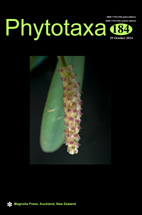Abstract
Berberis sect. Wallichianae are species of evergreen shrubs that in Taiwan are found in subalpine and montane-temperate areas and which have a notoriously controversial taxonomic history. Based on multivariate statistical analyses of morphometric data and an explicitly stated species criterion, the taxonomy of the group in Taiwan and its close relative in Luzon (B. barandana) is revised and their endemicity is evaluated by molecular data. In addition to the six species recognized in the Flora of Taiwan, 2nd ed. (i.e., B. aristatoserrulata, B. brevisepala, B. chingshuiensis, B. kawakamii, B. mingetsensis, and B. tarokoensis), B. hayatana (synonymized under B. mingetsensis) and B. nantoensis (synonymized under B. brevisepala) are reinstated, and three new species (B. pengii, B. ravenii, and B. schaaliae) are described and illustrated. Phylogenetic analyses using three chloroplast DNA sequence regions (rbcL, ycf6-psbM, and psbA-trnH) place all Taiwanese species and B. barandana in a strongly supported clade derived from within the continental Asian species of sect. Wallichianae, indicating their independent evolutionary history and supporting their endemic status.

